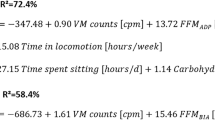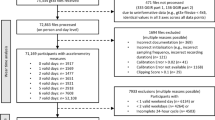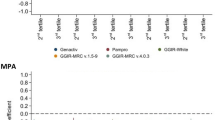Abstract
Background/Objectives:
Activity-related energy expenditure (AEE) might be an important factor in the etiology of chronic diseases. However, measurement of free-living AEE is usually not feasible in large-scale epidemiological studies but instead has traditionally been estimated based on self-reported physical activity. Recently, accelerometry has been proposed for objective assessment of physical activity, but it is unclear to what extent this methods explains the variance in AEE.
Subjects/Methods:
We conducted a systematic review searching MEDLINE database (until 2014) on studies that estimated AEE based on accelerometry-assessed physical activity in adults under free-living conditions (using doubly labeled water method). Extracted study characteristics were sample size, accelerometer (type (uniaxial, triaxial), metrics (for example, activity counts, steps, acceleration), recording period, body position, wear time), explained variance of AEE (R2) and number of additional predictors. The relation of univariate and multivariate R2 with study characteristics was analyzed using nonparametric tests.
Results:
Nineteen articles were identified. Examination of various accelerometers or subpopulations in one article was treated separately, resulting in 28 studies. Sample sizes ranged from 10 to 149. In most studies the accelerometer was triaxial, worn at the trunk, during waking hours and reported activity counts as output metric. Recording periods ranged from 5 to 15 days. The variance of AEE explained by accelerometer-assessed physical activity ranged from 4 to 80% (median crude R2=26%). Sample size was inversely related to the explained variance. Inclusion of 1 to 3 other predictors in addition to accelerometer output significantly increased the explained variance to a range of 12.5–86% (median total R2=41%). The increase did not depend on the number of added predictors.
Conclusions:
We conclude that there is large heterogeneity across studies in the explained variance of AEE when estimated based on accelerometry. Thus, data on predicted AEE based on accelerometry-assessed physical activity need to be interpreted cautiously.
This is a preview of subscription content, access via your institution
Access options
Subscribe to this journal
Receive 12 print issues and online access
$259.00 per year
only $21.58 per issue
Buy this article
- Purchase on Springer Link
- Instant access to full article PDF
Prices may be subject to local taxes which are calculated during checkout




Similar content being viewed by others
References
World Health Organization Global Recommendations on Physical Activity for Health. World Health Organization: Geneva, 2010.
Zheng C, Beresford SA, Van Horn L, Tinker LF, Thomson CA, Neuhouser ML et al. Simultaneous association of total energy consumption and activity-related energy expenditure with risks of cardiovascular disease, cancer, and diabetes among postmenopausal women. Am J Epidemiol 2014; 180: 526–535.
Caspersen CJ, Powell KE, Christenson GM . Physical activity, exercise, and physical fitness: definitions and distinctions for health-related research. Public Health Rep 1985; 100: 126–131.
Plasqui G, Westerterp KR . Physical activity assessment with accelerometers: an evaluation against doubly labeled water. Obesity (Silver Spring) 2007; 15: 2371–2379.
Plasqui G, Bonomi AG, Westerterp KR . Daily physical activity assessment with accelerometers: new insights and validation studies. Obes Rev 2013; 14: 451–462.
Van Remoortel H, Giavedoni S, Raste Y, Burtin C, Louvaris Z, Gimeno-Santos E et al. Validity of activity monitors in health and chronic disease: a systematic review. Int J Behav Nutr Phys Act 2012; 9: 84.
Westerterp KR . Physical activity and physical activity induced energy expenditure in humans: measurement, determinants, and effects. Front Physiol 2013; 4: 90.
Westerterp KR . Physical activity as determinant of daily energy expenditure. Physiol Behav 2008; 93: 1039–1043.
Westerterp KR . Assessment of physical activity: a critical appraisal. Eur J Appl Physiol 2009; 105: 823–828.
Pinheiro Volp AC, Esteves de Oliveira FC, Duarte Moreira Alves R, Esteves EA, Bressan J . Energy expenditure: components and evaluation methods. Nutr Hosp 2011; 26: 430–440.
Ainsworth BE, Haskell WL, Herrmann SD, Meckes N, Bassett DR Jr, Tudor-Locke C et al. 2011 Compendium of Physical Activities: a second update of codes and MET values. Med Sci Sports Exerc 2011; 43: 1575–1581.
German National Cohort Consortium. The German National Cohort: aims, study design and organization. Eur J Epidemiol 2014; 29: 371–382.
Warren JM, Ekelund U, Besson H, Mezzani A, Geladas N, Vanhees L . Assessment of physical activity - a review of methodologies with reference to epidemiological research: a report of the exercise physiology section of the European Association of Cardiovascular Prevention and Rehabilitation. Eur J Cardiovasc Prev Rehabil 2010; 17: 127–139.
Speakman JR . The history and theory of the doubly labeled water technique. Am J Clin Nutr 1998; 68: 932S–938S.
Rabinovich RA, Louvaris Z, Raste Y, Langer D, Van Remoortel H, Giavedoni S et al. Validity of physical activity monitors during daily life in patients with COPD. Eur Respir J 2013; 42: 1205–1215.
Colbert LH, Matthews CE, Havighurst TC, Kim K, Schoeller DA . Comparative validity of physical activity measures in older adults. Med Sci Sports Exerc 2011; 43: 867–876.
Pomeroy J, Brage S, Curtis JM, Swan PD, Knowler WC, Franks PW . Between-monitor differences in step counts are related to body size: implications for objective physical activity measurement. PLoS One 2011; 6: e18942.
Leenders NY, Sherman WM, Nagaraja HN, Kien CL . Evaluation of methods to assess physical activity in free-living conditions. Med Sci Sports Exerc 2001; 33: 1233–1240.
van Hees VT, Renstrom F, Wright A, Gradmark A, Catt M, Chen KY et al. Estimation of daily energy expenditure in pregnant and non-pregnant women using a wrist-worn tri-axial accelerometer. PLoS One 2011; 6: e22922.
Assah FK, Ekelund U, Brage S, Corder K, Wright A, Mbanya JC et al. Predicting physical activity energy expenditure using accelerometry in adults from sub-Sahara Africa. Obesity (Silver Spring) 2009; 17: 1588–1595.
Bonomi AG, Plasqui G, Goris AH, Westerterp KR . Estimation of free-living energy expenditure using a novel activity monitor designed to minimize obtrusiveness. Obesity (Silver Spring) 2010; 18: 1845–1851.
Bonomi AG, Plasqui G, Goris AH, Westerterp KR . Improving assessment of daily energy expenditure by identifying types of physical activity with a single accelerometer. J Appl Physiol (1985) 2009; 107: 655–661.
Masse LC, Fulton JE, Watson KL, Mahar MT, Meyers MC, Wong WW . Influence of body composition on physical activity validation studies using doubly labeled water. J Appl Physiol (1985) 2004; 96: 1357–1364.
Plasqui G, Joosen AM, Kester AD, Goris AH, Westerterp KR . Measuring free-living energy expenditure and physical activity with triaxial accelerometry. Obes Res 2005; 13: 1363–1369.
Horner F, Bilzon JL, Rayson M, Blacker S, Richmond V, Carter J et al. Development of an accelerometer-based multivariate model to predict free-living energy expenditure in a large military cohort. J Sports Sci 2013; 31: 354–360.
Kinnunen H, Tanskanen M, Kyrolainen H, Westerterp KR . Wrist-worn accelerometers in assessment of energy expenditure during intensive training. Physiol Meas 2012; 33: 1841–1854.
Valenti G, Camps SG, Verhoef SP, Bonomi AG, Westerterp KR . Validating measures of free-living physical activity in overweight and obese subjects using an accelerometer. Int J Obes (Lond) 2014; 38: 1011–1014.
Skipworth RJ, Stene GB, Dahele M, Hendry PO, Small AC, Blum D et al. Patient-focused endpoints in advanced cancer: criterion-based validation of accelerometer-based activity monitoring. Clin Nutr 2011; 30: 812–821.
Assah FK, Ekelund U, Brage S, Wright A, Mbanya JC, Wareham NJ . Accuracy and validity of a combined heart rate and motion sensor for the measurement of free-living physical activity energy expenditure in adults in Cameroon. Int J Epidemiol 2011; 40: 112–120.
Pietilainen KH, Kaprio J, Borg P, Plasqui G, Yki-Jarvinen H, Kujala UM et al. Physical inactivity and obesity: a vicious circle. Obesity (Silver Spring) 2008; 16: 409–414.
Adams SA, Matthews CE, Ebbeling CB, Moore CG, Cunningham JE, Fulton J et al. The effect of social desirability and social approval on self-reports of physical activity. Am J Epidemiol 2005; 161: 389–398.
Bouten CV, Verboeket-van de Venne WP, Westerterp KR, Verduin M, Janssen JD . Daily physical activity assessment: comparison between movement registration and doubly labeled water. J Appl Physiol (1985) 1996; 81: 1019–1026.
Tudor-Locke C, Martin CK, Brashear MM, Rood JC, Katzmarzyk PT, Johnson WD . Predicting doubly labeled water energy expenditure from ambulatory activity. Appl Physiol Nutr Metab 2012; 37: 1091–1100.
Chen KY, Bassett DR Jr . The technology of accelerometry-based activity monitors: current and future. Med Sci Sports Exerc 2005; 37: S490–S500.
Esliger DW, Tremblay MS . Technical reliability assessment of three accelerometer models in a mechanical setup. Med Sci Sports Exerc 2006; 38: 2173–2181.
Welk GJ, McClain J, Ainsworth BE . Protocols for evaluating equivalency of accelerometry-based activity monitors. Med Sci Sports Exerc 2012; 44: S39–S49.
Herrmann SD, Barreira TV, Kang M, Ainsworth BE . Impact of accelerometer wear time on physical activity data: a NHANES semisimulation data approach. Br J Sports Med 2014; 48: 278–282.
Trost SG, McIver KL, Pate RR . Conducting accelerometer-based activity assessments in field-based research. Med Sci Sports Exerc 2005; 37: S531–S543.
Vanhelst J, Beghin L, Duhamel A, Bergman P, Sjostrom M, Gottrand F . Comparison of uniaxial and triaxial accelerometry in the assessment of physical activity among adolescents under free-living conditions: the HELENA study. BMC Med Res Methodol 2012; 12: 26.
Prentice AM, Goldberg GR, Murgatroyd PR, Cole TJ . Physical activity and obesity: problems in correcting expenditure for body size. Int J Obes Relat Metab Disord 1996; 20: 688–691.
Westerterp KR . Reliable assessment of physical activity in disease: an update on activity monitors. Curr Opin Clin Nutr Metab Care 2014; 17: 401–406.
Acknowledgements
Author contributions
All authors designed the study. SJ conducted the search and screened the abstracts; SJ and AS conducted full-text screening and data extraction. SJ analyzed the data and all authors interpreted the data. SJ drafted the manuscript. All authors revised and approved the final version.
Author information
Authors and Affiliations
Corresponding author
Ethics declarations
Competing interests
The authors declare no conflict of interest.
Additional information
Supplementary Information accompanies this paper on International Journal of Obesity website
Supplementary information
Rights and permissions
About this article
Cite this article
Jeran, S., Steinbrecher, A. & Pischon, T. Prediction of activity-related energy expenditure using accelerometer-derived physical activity under free-living conditions: a systematic review. Int J Obes 40, 1187–1197 (2016). https://doi.org/10.1038/ijo.2016.14
Received:
Revised:
Accepted:
Published:
Issue Date:
DOI: https://doi.org/10.1038/ijo.2016.14
This article is cited by
-
Factors associated with habitual time spent in different physical activity intensities using multiday accelerometry
Scientific Reports (2020)
-
Issues in Measuring and Interpreting Energy Balance and Its Contribution to Obesity
Current Obesity Reports (2019)
-
Uni- and triaxial accelerometric signals agree during daily routine, but show differences between sports
Scientific Reports (2018)
-
Usefulness of motion sensors to estimate energy expenditure in children and adults: a narrative review of studies using DLW
European Journal of Clinical Nutrition (2017)
-
Energy expenditure estimation from respiration variables
Scientific Reports (2017)



